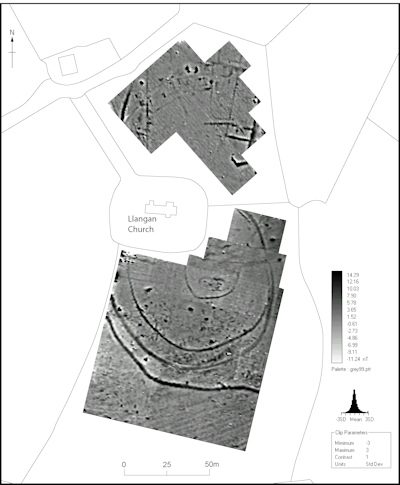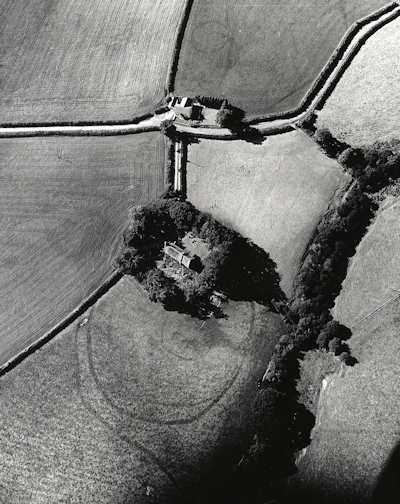
Reuse of Iron Age hillforts and defended settlements in the Roman period and the medieval period is attested at many sites by excavation, documentary sources and by the earthwork morphology of the forts or enclosures themselves.
Many writers have argued that light political and economic control of the Atlantic zone of Wales ensured that for many the Roman conquest and governance of Britain had minimal impact on daily life. Occasional finds of artefacts from coastal promontory forts, from south-west and north-west Wales, and evidence from excavations on defended settlements demonstrates continued use of these sites in the Roman period, while rectangular stone buildings within the enclosures at Cwmbrwyn, Carmathenshire (Ward 1907), and Trelissey, Pembrokeshire (Thomas and Walker 1958-60), are evidence of greater Roman influence. There is nothing, however, on the Atlantic coast to compare with the Roman villa constructed over Iron Age roundhouses within a defended settlement at Whitton in the heavily Romanised Vale of Glamorgan of south-east Wales (Jarrett and Wrathmell 1981).
Roman occupation is relatively easy to detect owing to the (relatively) large number of easily recognisable artefacts that accompanies it. However, artefacts dating to the immediate post-Roman period are rare, and consequently evidence for the reuse of sites in this period is more difficult to detect. Intermittent or low-level post-Roman occupation has been identified on the defended settlements at Llawhaden (Williams and Mytum 1998), Brawdy Castle and Walesland Rath (Wainwright 1971), all in Pembrokeshire. Aerial photographic evidence and recent geophysical survey at Llangan in Carmarthenshire attests that a medieval church lies within an Iron Age enclosure, an enclosure that is now reduced to a cropmark (Figure 12). The geophysical survey shows a possible rectangular building within the inner enclosure, potentially an early medieval structure (Figure 11). It is hardly surprising that post Roman reuse of Iron Age enclosures is difficult to identify when any settlement of this period is virtually unknown in Wales.


It is suspected that some medieval castles are founded on the sites of earlier defensive sites. For instance, during the Anglo-Norman conquest of Wales the Earl of Montgomery made straight for Pembroke, suggesting he was intent on capturing a pre-existing fort on which to found his timber castle. This was later replaced by the massive stone castle that still dominates the town. Roman coins from Pembroke strengthen the argument for an Iron Age/Roman and pre-Anglo-Norman fort. Clearer evidence comes from Carew Castle, Pembrokeshire, where excavations revealed several narrow defensive ditches (possibly early medieval) pre-dating the stone castle, and from Llansteffan Castle, Carmarthenshire, where the stone castle has been shown to be built within a substantial Iron Age fort. Excavation evidence can, however, often be difficult to interpret. For instance, at Castell, Porth Trefadog, Anglesey, excavations on a coastal cliff castle revealed 11th-12th century fortifications, possibly constructed by the Normans or Norse or in response to a Norman/Norse threat (Longley 1991). The 11th-12th century cliff castle was clearly built on an earlier multi-phase defensive site, but the evidence was unclear as to whether the earliest phase was Iron Age or later. The excavator considered it most likely to be Iron Age, although no direct dating evidence was discovered.
At many sites visible evidence is difficult to interpret. A good example of this is found at Nevern Castle in Pembrokeshire (King and Perks 1951; Turvey 1989). This castle enters history in the early 12th century AD when the Anglo-Norman lord, Robert Fitzmartin, established the caput of his newly conquered lands at Nevern. Towards the end of the century Rhys ap Gruffudd re-established Welsh rule in south Wales and retook Nevern. Rhys ap Gruffudd died in 1197, following which William Fitzmartin regained control of Nevern. William Fitzmartin decided not to refortify Nevern but to build a new castle and town a few miles downstream at Newport. Most authorities accept this basic history. However, some writers have focused on the medieval history of Nevern and interpreted the castle's remains as purely of the 12th century, while others have argued that the Fitzmartin and Rhys ap Gruffudd's castle are clearly built on the remains of an early medieval fortification, and cite Dinas Powys, a small multivallate fort in Glamorgan, as a parallel (Alcock 1963). The presence of Nevern Church, a major pre-Anglo-Norman ecclesiastical centre in the valley below the castle, is strong additional evidence for use of the site in this period. Others have remarked that below the medieval castle lies what seems to be an Iron Age inland promontory fort - Nevern is of a similar form and size and is located in a very similar position to Castell Henllys, a proven Iron Age fort, a few kilometres up the valley. However, several seasons of excavation by Chris Caple has not revealed any evidence for occupations earlier than 12th century, and so it appears that the castle was a medieval de novo construction (see interim excavation reports 2008-2017).
Internet Archaeology is an open access journal based in the Department of Archaeology, University of York. Except where otherwise noted, content from this work may be used under the terms of the Creative Commons Attribution 3.0 (CC BY) Unported licence, which permits unrestricted use, distribution, and reproduction in any medium, provided that attribution to the author(s), the title of the work, the Internet Archaeology journal and the relevant URL/DOI are given.
Terms and Conditions | Legal Statements | Privacy Policy | Cookies Policy | Citing Internet Archaeology
Internet Archaeology content is preserved for the long term with the Archaeology Data Service. Help sustain and support open access publication by donating to our Open Access Archaeology Fund.